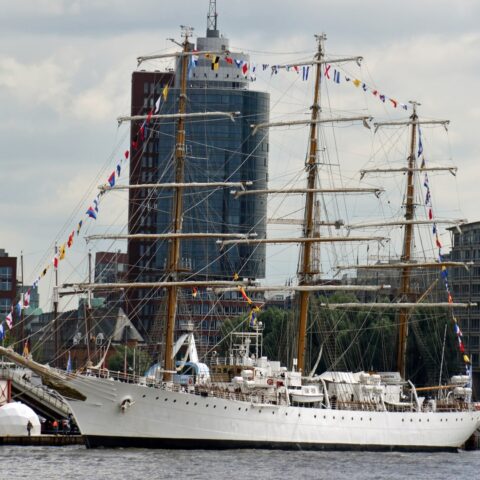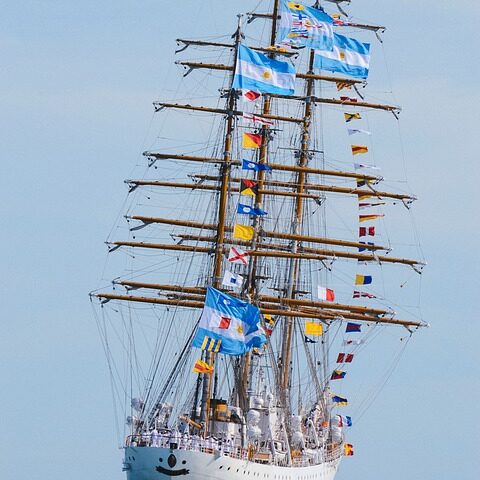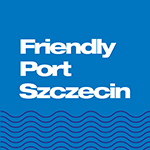Initially, students of the Navy Academy (Escuela Naval Militar), established in 1872, had their training on board of General Brown, a steam barque. Later, the training was provided on board of corvettes: Uruguay (1874-1887) and La Argentina (1884-1895), and full-rigger Presidente Sarmiento (since 1898). Libertad, built in the Birkenhead-based Laird Shipyard, sailed across oceans for nearly four decades. She welcomed on board crowned heads, including the German Emperor Wilhelm II and the last Russian Tsar Nikolai Romanov. Since 1938, the ageing ship had her training function gradually reduced. Deprived of sails, she made short cruises on local sea and inland waters (rivers of Parana, Rio de la Plata and Uruguay). She was to be replaced by a sailing ship funded, designed and built for the first time by Argentina. The concept design was developed by a naval architect Amelio D’Arcangelo, and the ship was built by the then new shipyard of Astillero Rio Santiago, in a port town of Ensenada near La Plata. When the first rivet was placed in the keel on 11th December 1953, the country was ruled by Juan Peron. Two years later, on 30th May 1956, when the ship was launched, the president was gone and the country’s leadership was taken over by the military. The coup d’etat was known as Revolucion Libertadora (Liberation Revolution), and the ship was actually named after the revolution. Libertad (or Liberty) fitted well into the then governing style and the new name of the ship was approved by a special decree of 27th April 1956.
Initially, the ship was not planned to be a full-rigger. Different types of the rig were considered. First, they wanted to make a barque, and then barquentine similar to Chilean Esmeralda. By coincidence, shortly after Libertad was launched, Chilean La Dama Blanca called at Buenos Aires. Argentinians carefully observed the vessel and her rigging they wanted to copy. They solicited opinions from Chilean sailors. To their surprise, opinions were not very favourable. In their opinion, the brigantine was difficult to operate and dangerous while turning. This might have been fuelled by a fatal accident on board of Esmeralda and somewhat limited experience in less than two-year service on board of a vessel. Argentinians drew their conclusions and in August 1956 they decided to alter the design. Finally, they went for a three-masted fully-rigged ship. The modification of the rig prolonged the building process by a year. The launching was further postponed as the building of the ship was accompanied by much political uncertainty. Finally, on 28th May 1963, the white and blue flag was hoisted at the stern of Libertad and the ship started her sail training service. At that time, she was the largest full-rigger in the world. Much later she gave in the first position to Polish Dar Młodzieży which started her service in 1982.
The tall ship included several surprising novelties. She had a level deck, tall wheelhouse close to the bow, no movable spars, streamlined silhouette, riveted hull, and a cruiser stern. One may have an impression that the stern smiles with two port lights looking like eyes, Argentina’s emblem corresponding to a nose, and a smiling mouth of an arched name of the vessel.
The figurehead is a woman wearing a Phrygian cap, a symbol of freedom and a part of the Argentinian national emblem. The sculpture is made of noble oak and it is called Nike after the Greek goddess of victory. Sha also has a common nickname of “La Gallega” (Galician woman) or Ursula. The latter is the name of a wife of a Galician sculptor Carlos Garcia Gonzalez. When he was vested in the task of making the sculpture he did not know that his wife was seriously ill. After we was widowed, he decided to make the sculpture looking like his beloved wife. Years later, he said that he had never been able to take his wife for a voyage, so he was happy to see her sculpture travel the world together with Libertad.
Ursula was not the first figurehead of the ship. The previous one, also a figure of a woman, was made by Luis Perotti. When Horacio Ferrari, the first captain of the ship, so the figurehead, he was horrified. The sculpture looked down, which did not bode well according to maritime believes. He requested to dismantle the figurehead immediately. Finally, it was placed in the Navy Museum in Tigre and, during the first years of the service, Libertad sailed without the figurehead. In the meantime, Gonzalez worked on the new figurehead in his studio in Retiro. It was fitted to the ship in 1964. Of course, now Ursula looks high above the horizon.
Libertad proved to be exceptionally fast. In 1966, she crossed the Atlantic in a record short time while sailing from west to east with an average speed in excess of 10 knots (at certain stretches she made 18 knots). She covered the distance of 2058 miles between the Race Cape in Newfoundland and the Dursey Island in Ireland in only 8 days 12 hours and 30 minutes. The record has never been broken by any other tall ship. Moreover, Argentinian sailors can be proud of winning the famous trophy of the Boston Teapot eight times. The trophy is presented to a ship which covers the longest distance in a given year within 124 hours. Libertad won this prestigious ranking in 1966, 1976, 1981, 1985, 1987, 1992, 2000, and 2007.
The ship circumnavigated the globe four times. For the first time in 1965 and later in 1970, 1997 and 2008. She was a regular participant to the most important tall ship races and regattas. One of them is particularly remembered. On 20th June 1976, at the start of the Hamilton Race from Bermuda to Newport, USA, Libertad collided with Juan Sebastian de Elcano. There was a tremendous hoard of ships (18 A class only). Seconds before the signal, Spanish schooner hit the Argentinian full-rigger with a bowsprit. She broke her foremast and withdrew from the race. One crew member had to stay in a hospital. Libertad pulled through without much damage and could continue the race. She completed the race but she was eventually disqualified as the race committee accepted a complaint filed by the Spanish ship which claimed to have the right of way. In his book “Tall Ships” (Almapress, 1996), Paul Bishop wrote: “Major, although not the immediate cause was the blunder made during the captains’ briefing before the start from Bermuda. It was agreed that captains could use motors until the start signal. It was decided under the pressure from captains who wanted to offer spectators an additional show by setting all sails still before passing the starting line. Everything went fine until the captain of one of large tall ships realised that he would cross the line too early and ordered to reverse engines. Before others realised what was going on, it was too late to avoid collision”.
Another incident broadly discussed in the world was the detention of Libertad in Ghana. On 2nd October 2012, a day after the tall ship called at the port of Tema, she was detained upon the motion by NML Capital. The detention was related to multimillion debt accumulated after Argentina’s bankruptcy of 2001. The situation enraged Buenos Aires. The press wrote about a scandal, and diplomatic letters full of indignation were sent to Ghana’s officials and international institutions. The court of Accra sustained the decision to detain. Debtors demanded that Argentina paid a deposit of 20 million dollars. Argentinians refused saying that Libertad was a navy vessel, and according to the international law she could not be detained. Argentinian arguments were confirmed by the International Maritime Organisation (IMO). On 15th December 2012, after 77 days into the detention, Ghana released the ship. The full-rigger made a triumphant return to her home country and was welcomed by cheering crowds in Mar del Plata. The case ended in June 2013 when the Ghana’s Supreme Court confirmed that the detention was unjustified and could end in a military conflict. The court also ruled on a compensation of 8 million dollars of port fees to be paid by NML Capital to the Port of Tema for the stay of the Argentinian ship in the port. Grasp all, lose all!
In 2004-2007, the ship underwent overhaul in her shipyard. They replaced the engine, standing and running rigging, and rebuilt living quarters. Now, also women can sail on board of Libertad, and they actually account for about 20 percent of the training crew. In the same vein as other tall ships of Latin America, Argentinians also make yard parades on entering and leaving ports. However, Libertad’s parades are slightly different as only five cadets are spaced out on each yard.
Libertad is 103.75 m long and her mainmast is 49.8 m. It has 27 sails of total 2650 square metres. For salutes, they use four 47 mm cannons fitted on the foredeck.
Libertad is well-known in Russia, but not for her frequent visits but the fact that the image of the tall ship can be found on 500-ruble banknotes in 1997-2011. How was it possible? In his interview, Russian graphic artist admitted that the original design, which included a steam ship, was rejected by the Russian Central Bank. Then, the artist painted a tall ship based on a random picture. By accident, it was the photograph of the Argentinian full-rigger.
a
103,75 m
frigate
1963
Ensenada
Libertad (Argentine)
Length overall: 103.75 m
Type: full-rigger
Year built: 1963
Shipyard: Ensenada
Home port: Buenos Aires








